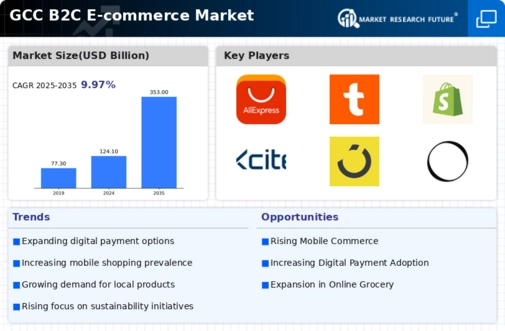Mobile Commerce Growth
Mobile commerce is becoming a pivotal driver in the Global GCC B2C E-commerce Market Industry. With the proliferation of smartphones, consumers are increasingly utilizing mobile devices for online shopping. As of 2024, mobile commerce is anticipated to account for over 50% of total e-commerce sales in the region. This shift towards mobile platforms is indicative of changing consumer preferences, as users seek convenience and accessibility. The market's trajectory suggests that by 2035, the industry could reach a valuation of 60 USD Billion, with mobile commerce playing a crucial role in this growth. The integration of mobile payment solutions further enhances this trend.
Diverse Product Offerings
The Global GCC B2C E-commerce Market Industry benefits from a diverse range of product offerings that cater to various consumer needs. Retailers are increasingly expanding their online catalogs to include electronics, fashion, beauty products, and groceries, thereby attracting a broader audience. This diversification is essential for sustaining consumer interest and driving sales. As the market evolves, it is likely to witness a compound annual growth rate of 8.28% from 2025 to 2035. The availability of unique and varied products enhances the overall shopping experience, encouraging consumers to explore e-commerce platforms for their purchasing needs.
Rising Internet Penetration
The Global GCC B2C E-commerce Market Industry is experiencing a surge in internet penetration across the region. As of 2024, internet penetration in the GCC is projected to reach approximately 99%, facilitating seamless online shopping experiences. This connectivity fosters consumer engagement and drives e-commerce growth. With a growing number of users accessing e-commerce platforms, the market is expected to generate revenues of around 25 USD Billion in 2024. The increasing reliance on digital platforms for shopping is likely to bolster the industry's expansion, as consumers increasingly prefer the convenience of online transactions over traditional retail.
Government Initiatives and Support
Government initiatives play a crucial role in fostering the Global GCC B2C E-commerce Market Industry. Various GCC countries are implementing policies to promote digital transformation and e-commerce growth. Initiatives such as regulatory frameworks, tax incentives, and infrastructure development are designed to create a conducive environment for online businesses. These efforts are likely to enhance consumer trust and encourage investment in the e-commerce sector. As a result, the market is expected to thrive, with projections indicating a revenue of 25 USD Billion in 2024. Such government support is instrumental in shaping the future landscape of e-commerce in the region.
Enhanced Logistics and Delivery Services
Logistics and delivery services are integral to the success of the Global GCC B2C E-commerce Market Industry. The region is witnessing advancements in logistics infrastructure, including warehousing and last-mile delivery solutions. Companies are investing in technology to streamline operations and improve delivery times, which is crucial for customer satisfaction. As e-commerce continues to grow, efficient logistics will become increasingly important. This trend is expected to contribute to the market's growth, with a projected valuation of 60 USD Billion by 2035. Enhanced logistics capabilities are likely to facilitate a smoother shopping experience, thereby attracting more consumers to online platforms.



















